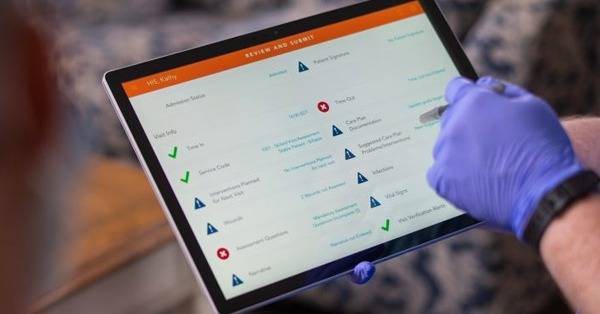- Solutions
- Solutions
- Home Health
- Hospice
- Life Plan Community
- Palliative Care
- Private Duty
- Senior Living
- Skilled Nursing
- Skilled Nursing
- Skilled Nursing Software
- Advanced Insights
- Customer relationship management
- Data and analytics
- Financial & operations management
- Marketing
- Nutrition management
- Referral management
- Regulatory compliance
- Retail management
- Resident engagement
- Revenue cycle management
- Skilled nursing interoperability
- Partners
- Blogs
- Resources
- About
- User Conference

The basics of value-based care
The move to value-based care is a significant shift for providers, payors and patients. Because it affects everyone, it’s important to understand the reasons behind this change and how you will need to transform your organization to continue providing high quality care and while getting the reimbursement you need to stay in business.
We’ll cover the basic concepts behind value-based care in this article. In later posts, we’ll explore clinical implications, operational changes organizations may want to consider, and financial considerations affecting reimbursement.
What’s behind the change?
About 25 years ago, healthcare providers, payors and policymakers began to see that the existing fee-for-service model had problems. The fee-for-service reimbursement model traditionally emphasized the volume of healthcare services provided, rather than the quality of outcomes achieved. This approach often led to a high-cost, fragmented healthcare delivery system with insufficient focus on patient outcomes. The term value-based care was coined by Michael Porter and Elizabeth Olmsted Teisberg in 2006 to describe their idea to restructure healthcare by incentivizing providers based on the value they provide to patients, measured by better outcomes, rather than the number of services delivered.
As the number of older Americans needing healthcare grows, it’s clear that the fee-for-service model is truly unsustainable. The U.S. spends more than most other countries on healthcare, and yet our life expectancy, infant mortality rates and overall population health are no better than many countries that spend much less. The fee-for-service model has proven to be ineffective at producing high quality outcomes. With our growing senior population we need to transition to models supporting better care and cost containment.
Value-based care defined
Put simply, value-based care is designed to focus on care quality, not the quantity of services delivered to a patient. This means four main things:
- Providers are responsible for outcomes.
- Care is integrated and must be coordinated and managed across entire care teams, providers and systems
- Care delivery should be holistic, considering physical, mental, behavioral, and social needs
- Patient goals and preferences are at the center of plan of care development.
In short, the old ways of independently treating patients in silos is gone. Providers ordering tests without gathering existing patient data is no longer accepted practice. That system offered no incentive for a provider to avoid duplication and manage total spend by assessing whether the same test had been ordered by another provider. So now, although there are different business models, it boils down to this: Provider reimbursement will be based on efficient, high-quality care and patient outcomes rather than independent services provided.
- Benchmarking
- Risk scoring
- Integrated care and care coordination
- Preventive care/wellness
- Relationships and networks
- Cost containment
*Health Care Payment Learning & Action Network, 2021
Fee-for-service: episodic | Value-based care: team-based |
|---|---|
Pro: Autonomy and more direct relationship of services rendered to revenue
| Pro: Reimbursement affected by efficiency, cost containment and quality outcomes
|
Pro: Patients who require many procedures can obtain them without concern for total cost of care
| Pro: Team-based. Focused on patient outcomes, increased care coordination and person-centric care |
Con: Incentivized for more service and procedure delivery | Con: Narrow networks and limits on choice |
Con: Individual provider focus. Lack of care coordination, resulting in duplication and missing information | Con: Providers who manage complex/costly patient populations are at greater financial risk
|
Risk: Healthcare overutilization and lack of outcome alignment
| Risk: High-risk patient avoidance |
Find out how MatrixCare can help your organization thrive under value-based care models.
Allison Rainey
As our Head of Nursing and Clinical Informatics, Allison Rainey oversees the deployment of clinical technologies. As a Registered Nurse and License Family Practitioner, Allison drives a caregiver-first approach in our products, collaborating closely with product leaders to ensures our products and services prioritize the needs and challenges faced by healthcare providers. By aligning workflows, designs, and overall product strategy, Allison strives to offer the most user-friendly, clinically superior, and efficient suite of comprehensive solutions in the industry. Allison brings extensive post-acute care experience from her 20-year tenure at NHC, one the largest publicly traded Senior Care providers in the U.S. She is a seasoned leader in population health management strategy, clinical reporting and analytics development, and inpatient hospital care. In her most recent role as AVP of Clinical Information Technology, she oversaw the deployment and utilization of various clinical technologies, including the MatrixCare EHR, across the extensive NHC network. Allison holds a Bachelor’s and a Master’s in Nursing from the University of Tennessee.
Related Posts




See MatrixCare in action
Start by having a call with one of our experts to see our platform in action.
MatrixCare offers industry-leading software solutions. Thousands of facility-based and home-based care organizations trust us to help them improve efficiency and provide exceptional care.
© 2026 MatrixCare is a registered trademark of MatrixCare. All rights reserved.




